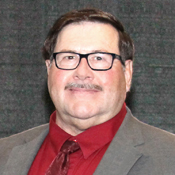The Most Diversified Weed...Waterhemp!
Apr 06, 2022
We have been dealing with waterhemp at the Deerfield location going back to the mid 1990s. We identified it in some of our grower’s peat fields raising mint. Waterhemp is in the same family as smooth and redroot pigweed. Originally it was misidentified by many early on as just pigweed. The characteristics of tall and common waterhemp that differ are that it has no hair on any above ground plant parts and has a waxy/shiny hue. The leaves are longer and narrower too. Mint lost its competitive edge when mites infested the buds reducing oil yields and falling mint oil prices in the late 90s and early 2000s. Almost all these fields transitioned back to corn, soybeans, or grass hay production. A couple producers grow sod for landscape markets locally in Madison and to larger cities like Chicago and Milwaukee.
Waterhemp is the most problematic weed we currently are fighting. Over the years, waterhemp has moved from low ground fields onto highland fields. The seed spreads from field to field in clods of soil on tillage equipment. People purchasing various used equipment contaminated with weed seed from other areas around the country. And many wildlife species carry weed seed across counties and over states while migrating with the seasons. Waterhemp is a very prolific seed producing weed. It can produce 100,000 to 2,000,000 seeds per plant. Waterhemp is a dioecious plant, meaning it has male and female plants. This type of biology leads to cross pollination which greatly increases plant genetic diversity.
This is the most thorough list of management practices to help reduce and control weeds. It is from the Weed Science Society of America (WSSA).
The best way to get waterhemp under control is reducing the seedbank by not allowing any waterhemp to produce any viable seed to add to the weed seedbank. The easiest waterhemp to control is the one that never emerges. Applying an effective multimode residual herbicide at the start of the season whether within a burndown herbicide application or after a tillage pass. This is the beginning of not letting waterhemp ever establish in this year’s crop. Your second pass of herbicide needs to be overlayed before your first pass residual runs out of killing power. This is usually 28-35 days after the 1st pass varying with initial timing and weather before and after.
Emerging technologies that give crops tolerances to post applied, post emerge chemicals are a helpful tool to utilize too. Currently, we have Roundup, Enlist, Liberty, and Xtend tolerant crops that are very effective in controlling susceptible weeds that are on label and in the height range. Tank mixing the appropriate contact and residual herbicides will further increase your chances for a weed-free field. The final important point would be to have a healthy, vigorous crop growing to canopy the ground as quickly as possible. This will greatly reduce the chance for weeds to get established and competing with the crop.
I will list a few practices I have seen fail over the years with continued overuse. One herbicide program consisting of one pass with one mode of action. Either weed species shift or resistance is identified. Herbicides being sprayed on too large of weeds, at too low of rates, and too late in the season. Another instance would be when a grower does not notice weeds four to five weeks after the last herbicide pass. The crop grows to a point where there are no labeled options left to fix the weed issues. Then a population of weeds escapes, go to seed and increase the weed seed bank for future years. This is very daunting when only about 5% of the weed seed bank germinates each year. Doing the math, it will take over three decades to get back to the original weed seed bank population.
I wish everyone a safe and prosperous growing season. Remember to contact your local United Cooperative agronomist to find success combating waterhemp and other weed issues. You can “Rely on Us” to formulate a specific herbicide program for each of your crops. Thanks and have a great year!!!

Waterhemp is the most problematic weed we currently are fighting. Over the years, waterhemp has moved from low ground fields onto highland fields. The seed spreads from field to field in clods of soil on tillage equipment. People purchasing various used equipment contaminated with weed seed from other areas around the country. And many wildlife species carry weed seed across counties and over states while migrating with the seasons. Waterhemp is a very prolific seed producing weed. It can produce 100,000 to 2,000,000 seeds per plant. Waterhemp is a dioecious plant, meaning it has male and female plants. This type of biology leads to cross pollination which greatly increases plant genetic diversity.
This is the most thorough list of management practices to help reduce and control weeds. It is from the Weed Science Society of America (WSSA).
- Understand the biology of the weeds present in your field.
- Use a diversified approach toward weed management and focus on reducing the number of weeds in the seedbank.
- Plant into weed-free fields and keep as weed-free as possible.
- Plant weed-free crop seed.
- Scout fields regularly.
- Use multiple effective herbicide modes of action (MOA’s).
- Apply the labeled herbicide rate at the recommended weed sizes.
- Emphasize cultural practices that suppress weeds.
- Use mechanical and biological management practices where appropriate.
- Prevent field-to-field and within-field movement of seed.
- Manage weed seed at harvest and after harvest to prevent buildup of weed seedbank.
- Prevent an influx of weeds into the field by managing field borders.
The best way to get waterhemp under control is reducing the seedbank by not allowing any waterhemp to produce any viable seed to add to the weed seedbank. The easiest waterhemp to control is the one that never emerges. Applying an effective multimode residual herbicide at the start of the season whether within a burndown herbicide application or after a tillage pass. This is the beginning of not letting waterhemp ever establish in this year’s crop. Your second pass of herbicide needs to be overlayed before your first pass residual runs out of killing power. This is usually 28-35 days after the 1st pass varying with initial timing and weather before and after.
Emerging technologies that give crops tolerances to post applied, post emerge chemicals are a helpful tool to utilize too. Currently, we have Roundup, Enlist, Liberty, and Xtend tolerant crops that are very effective in controlling susceptible weeds that are on label and in the height range. Tank mixing the appropriate contact and residual herbicides will further increase your chances for a weed-free field. The final important point would be to have a healthy, vigorous crop growing to canopy the ground as quickly as possible. This will greatly reduce the chance for weeds to get established and competing with the crop.
I will list a few practices I have seen fail over the years with continued overuse. One herbicide program consisting of one pass with one mode of action. Either weed species shift or resistance is identified. Herbicides being sprayed on too large of weeds, at too low of rates, and too late in the season. Another instance would be when a grower does not notice weeds four to five weeks after the last herbicide pass. The crop grows to a point where there are no labeled options left to fix the weed issues. Then a population of weeds escapes, go to seed and increase the weed seed bank for future years. This is very daunting when only about 5% of the weed seed bank germinates each year. Doing the math, it will take over three decades to get back to the original weed seed bank population.
I wish everyone a safe and prosperous growing season. Remember to contact your local United Cooperative agronomist to find success combating waterhemp and other weed issues. You can “Rely on Us” to formulate a specific herbicide program for each of your crops. Thanks and have a great year!!!

Corey Dean
Location Manager/Agronomy Sales | Eastern Region

David Cramer
Filed Under: Agronomy, Crop Protection